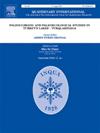Loess provenance in the westernmost part of the lower Danube Basin, Serbia: Geochemical insights from the Velika Vrbica fluvial–eolian section
IF 1.8
3区 地球科学
Q3 GEOGRAPHY, PHYSICAL
引用次数: 0
Abstract
Our study examined the chemical composition of fluvial and eolian sediments at the Velika Vrbica multisection, located on the bank of the Danube River in eastern Serbia, within the westernmost part of the lower Danube (Dacian) Basin. The multisection comprises two discrete sections: an older 2.7 m thick fluvial section, and a younger 11.2 m thick loess-paleosol sequence (LPS). These are exposed along the sides of a gully incised into a Danube River terrace that is covered by loess. Using luminescence dating, litho- and pedo-stratigraphy, and weathering proxies, we conclude that the fluvial section formed during Marine Isotope Stage (MIS) 6, and the overlying loess spans semi-continuously from late MIS 6 to the present. In order to use only elemental ratios unaffected by weathering and grain-size sorting, and thus serving as reliable provenance proxies, we introduce a novel statistical parameter – the path adherence coefficient (PAC). Along with the PAC, we also employ the well-established R2 on geochemical data from the fluvial sediments. We identified Zr/Al2O3 and TiO2/Al2O3 ratios as the most reliable provenance proxies, enabling us to discern temporal variations in sediment provenance at the Velika Vrbica LPS. The fine-grained portions of the LPS exhibit a significantly different provenance than that of the Danube River sediments. This difference is attributed to the transport of fine, loessial material over long distances, incorporating multiple sediment sources (likely originating from the Carpathians), from beyond the Danube River alluvium, into the loess. In contrast, the coarser, sand-rich sediment within the Velika Vrbica LPS section, which formed during MIS 2, has a more local provenance, having been derived almost exclusively from Danube River alluvium.
塞尔维亚多瑙河下游盆地最西端的黄土物源:来自Velika Vrbica河流-风成剖面的地球化学见解
我们的研究检查了位于塞尔维亚东部多瑙河岸边的Velika Vrbica多剖面的河流和风成沉积物的化学成分,该剖面位于多瑙河下游(达契亚)盆地的最西端。多剖面包括两个独立的剖面:一个较老的2.7 m厚的河流剖面和一个较年轻的11.2 m厚的黄土-古土壤层序(LPS)。它们暴露在多瑙河阶地的沟壑两侧,沟壑被黄土覆盖。利用发光测年、岩石学和土壤地层学以及风化等指标,我们认为河流剖面形成于海洋同位素阶段(MIS) 6,其上覆黄土从MIS 6晚期到现在是半连续的。为了仅使用不受风化和粒度分选影响的元素比率,从而作为可靠的物源代理,我们引入了一个新的统计参数-路径附着系数(PAC)。与PAC一起,我们还对河流沉积物的地球化学数据采用了成熟的R2。我们确定Zr/Al2O3和TiO2/Al2O3比值是最可靠的物源指标,使我们能够识别Velika Vrbica LPS沉积物物源的时间变化。LPS的细粒部分与多瑙河沉积物的物源明显不同。这种差异是由于细小的黄土物质经过长途运输,将多瑙河冲积层以外的多种沉积物来源(可能来自喀尔巴阡山脉)结合到黄土中。相比之下,在MIS 2期间形成的Velika Vrbica LPS剖面中较粗的富砂沉积物具有更本地的物源,几乎完全来自多瑙河冲积物。
本文章由计算机程序翻译,如有差异,请以英文原文为准。
求助全文
约1分钟内获得全文
求助全文
来源期刊

Quaternary International
地学-地球科学综合
CiteScore
5.60
自引率
4.50%
发文量
336
审稿时长
3 months
期刊介绍:
Quaternary International is the official journal of the International Union for Quaternary Research. The objectives are to publish a high quality scientific journal under the auspices of the premier Quaternary association that reflects the interdisciplinary nature of INQUA and records recent advances in Quaternary science that appeal to a wide audience.
This series will encompass all the full spectrum of the physical and natural sciences that are commonly employed in solving Quaternary problems. The policy is to publish peer refereed collected research papers from symposia, workshops and meetings sponsored by INQUA. In addition, other organizations may request publication of their collected works pertaining to the Quaternary.
 求助内容:
求助内容: 应助结果提醒方式:
应助结果提醒方式:


